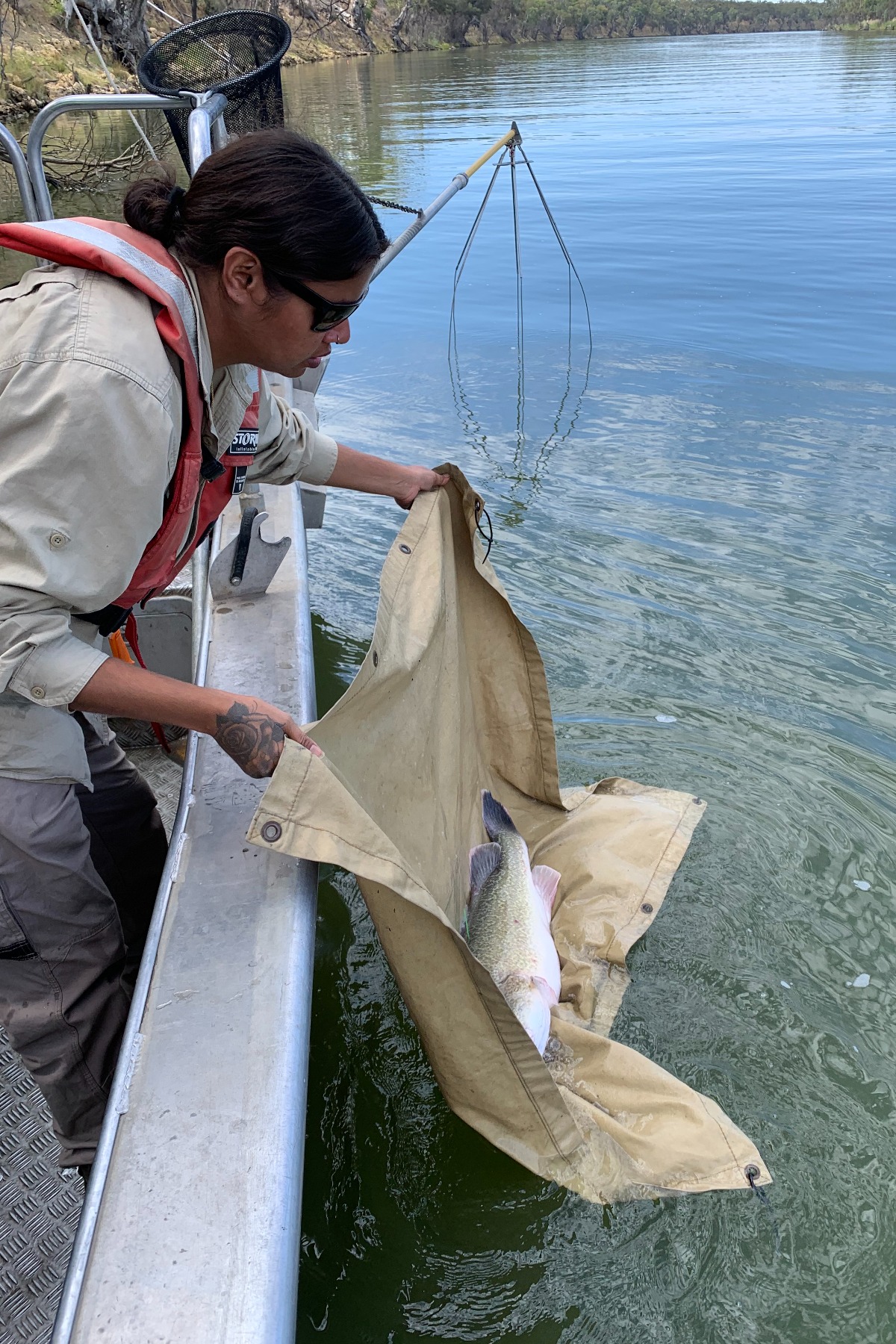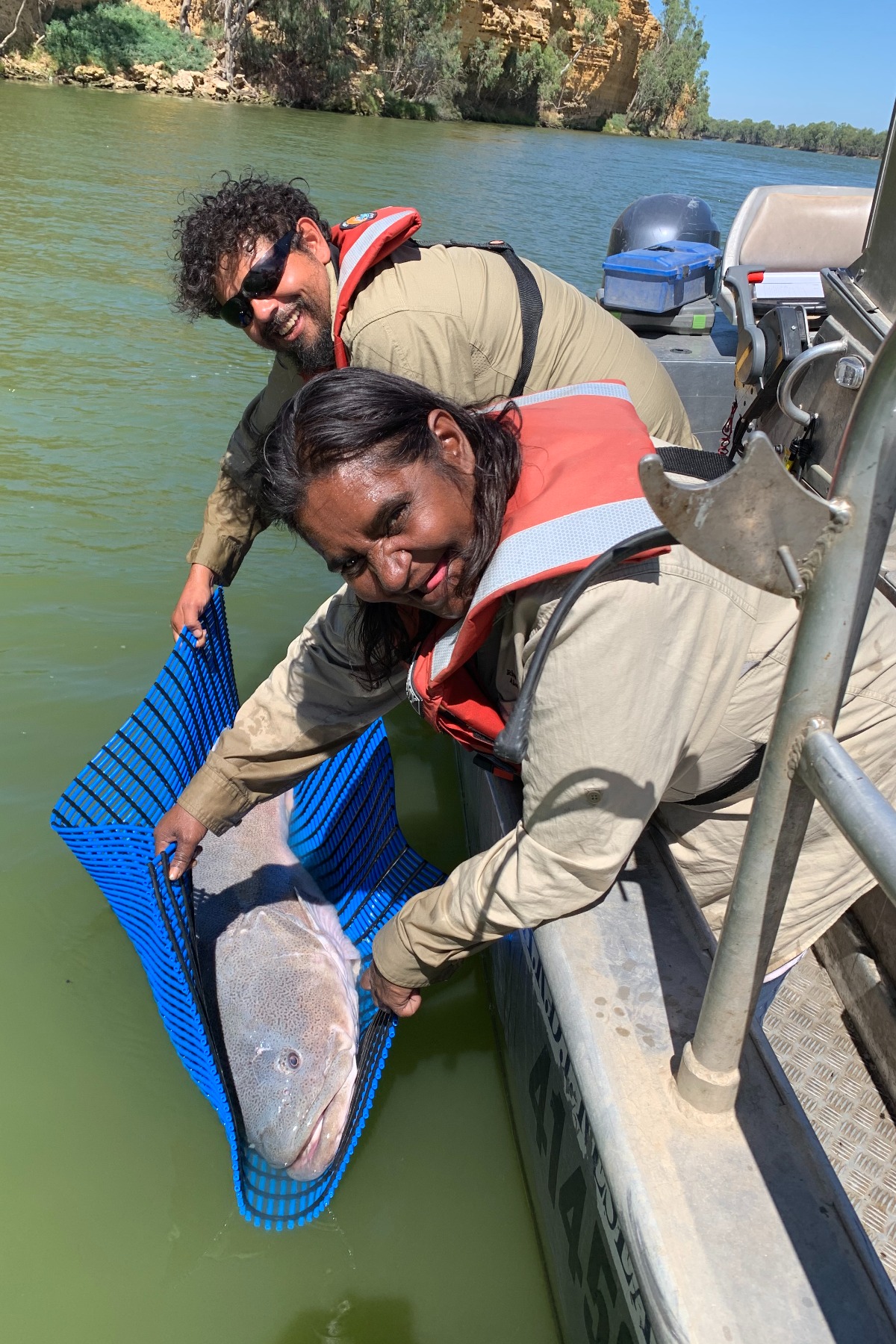Collaboration supports the flow of culture and knowledge
A recent environmental undertaking in the Lower Murray has highlighted the power of collaboration in promoting river flow and protecting and restoring iconic native fish species.

The Pondi (Murray cod) monitoring project united First Nations knowledge with modern-day science, as rangers from the Ngarrindjeri Aboriginal Corporation (NAC) and River Murray and Mallee Aboriginal Corporation (RMMAC) worked together with South Australian Research and Development Institute (SARDI) researchers.
The project was funded by the Australian Government through the Commonwealth Environmental Water Holder’s (CEWH’s) Science Program, Flow Monitoring, Evaluation and Research (Flow-MER), with the fish sampling carried out over a week in February 2025. Identified by NAC and RMMAC as a priority for caring for country, Pondi monitoring was co-designed for First Nations rangers to join SARDI researchers to undertake fish sampling using electrofishing technology to collect data and gain a better understanding of Pondi abundance and population health in the Lower Murray.
“For the First Nations communities of the lower River Murray region, Pondi is central to the creation story of the river itself and has a long and continued cultural significance,” said Associate Professor Qifeng Ye, SARDI Inland Waters and Catchment Ecology Science Program Leader. “Historically, Pondi used to be highly abundant but the current population has substantially reduced. Some Elders say they haven’t seen Pondi in the river over the last 60 years. It’s really sad.”
Boat electrofishing was conducted on the River Murray between Renmark and Swan Reach, with six First Nations rangers and two SARDI researchers participated in the fish sampling. Pondi were brought on board to be measured, weighed and tagged. DNA samples were also taken before the fish were released close to their capture location.

“Throughout the week we sampled four sites along the river,” Associate Professor Ye said. “This was the first time both NAC and RMMAC had worked together with SARDI to monitor this iconic fish species. The rangers from both mobs connected well to each other, and with SARDI researchers.
“I think we have developed a great relationship and the rangers gained a better understanding about how SARDI does research to inform management.
You might like
“Most rangers were thrilled and impressed with the large Pondi they caught because they haven’t seen that before – they got goosebumps.”
Aboriginal Land Trust Raukkan ranger Steven Rigney (NAC) was on board for the Pondi monitoring project. “That was my first time electrofishing and my first time ever seeing and catching a Pondi, he said. “It felt beautiful to hold it. I can’t explain, but it felt good to me.
“We saw little baby ones and then a big one. On the last day I saw one that was nearly 1.2 metres. We saw all different sizes, but that was probably the biggest one. It was pretty good, because we don’t see them where we are.”
For RMMAC ranger Jamii-Leah Gray, catching 18 Pondi at Hogwash Bend has brought much-needed reassurance. “I’ve only caught carp or pilarki (golden perch) (so) knowing they’re in the river eases my tension,” she said.
“SARDI staff provided excellent instruction on electrofishing. After 10 seconds of electrocution, the fish regained consciousness. Initially sceptical of the boat’s voltage, it was fascinating to see the electrofishing method and the number of fish within a five-meter radius.”

RMMAC ranger Lucille Sumner said the experience gave her hope for the health and sustainability of the river. “For most of us we’ve never seen a Pondi that’s alive,” she said. “It was the best experience ever. Hoping that the future of our Murray cod is sustainable for our great Murray River.”
To share the experience with Elders and the broader local First Nations communities, a complementary Pondi Electrofishing Demonstration Day was held in Loxton during the monitoring week. There were around 50 participants, including Elders, rangers and community members from NAC and RMMAC, as well as supporting Australian and SA Government representatives present.
“So many people came to the event, including Elders from the far end of the River Murray: the Lakes and Coorong,” Associate Professor Ye said. “Uncle Eric gave a warm Welcome to Country, followed by a smoking ceremony by Uncles Phillip Johnson and Dale Abdulla. Elder Alban Kartinyeri from NAC acknowledged the invitation to visit and work on RMMAC country.
“I provided a brief introduction about the Flow-MER Program, the initiation of Pondi monitoring and why we want to work together, then CEWH local engagement officer Richard Mintern gave a talk from the funding body’s perspective. And then we hit the road.
“Elders and other attendees boarded a pontoon boat and we closely followed the electrofishing boat from a safe distance, observing the electrofishing activity and process used to capture Pondi. My staff and the rangers brought the catch back to the pontoon boat for people to observe how we measure and tag Pondi and other species.
“We shared our understanding about native fish ecology, and Elders shared their cultural knowledge and the historical river conditions and Pondi abundance. We did three pontoon boat runs and we also caught Pilarki (golden perch), Tcheri (silver perch) and Pyberry (bony herring). It was great that people could look at a diverse species and share other stories about native fish.
“We let the rangers do the netting at the front to pick up the fish and show people. They really enjoyed that and were very proud of the work. It was also great for the Elders see how we all worked together on Country.”

Later, on land, a yarning circle provided the opportunity for further discussion.
“We discussed how we could support the Pondi population recovery in the lower River Murray in the future – through promoting the delivery of water for the environment, habitat restoration and integrating cultural knowledge with western science to inform river restoration,” Associate Professor Ye said.
“Through engagement, you can have better community support. First Nations Elders and community members have an enduring connection to Country, land and water. We are committed to continuing to work together to ensure that integrated knowledge and science are used to inform ecosystem restoration and sustainable management of natural resources.”
Richard Mintern praised the Pondi monitoring project for its success in deepening relationships across borders. “This unique project has strengthened connections and sharing of knowledge in many ways: between the First Nations people, scientists and water managers; and between the NAC and RMMAC,” he said.
“It is a shining example showcasing what can be achieved when diverse groups come together with a common purpose.”
NAC project co-ordinator Alban Kartinyeri said the Pondi monitoring project was “a great project to establish current and future partnership with SARDI.”
“Engaging Raukkan/NAC and RMMAC rangers and bringing together the people who are working on Country (Ruwe) is important to us as First Nations people,” he said. “I look forward to and strongly encourage a continued partnership amongst First Nations that brings community together to care for Country, particularly the Ngarrindjeri people.”











